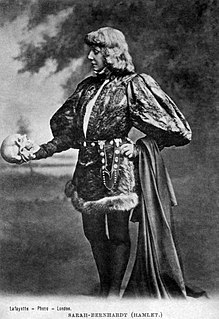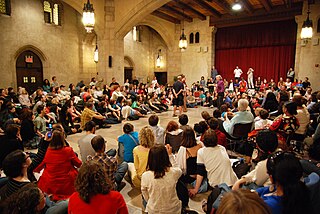
Acting is an activity in which a story is told by means of its enactment by an actor or actress who adopts a character—in theatre, television, film, radio, or any other medium that makes use of the mimetic mode.

Improvisational theatre, often called improvisation or improv, is the form of theatre, often comedy, in which most or all of what is performed is unplanned or unscripted: created spontaneously by the performers. In its purest form, the dialogue, action, story, and characters are created collaboratively by the players as the improvisation unfolds in present time, without use of an already prepared, written script.

Augusto Boal was a Brazilian theatre practitioner, drama theorist, and political activist. He was the founder of Theatre of the Oppressed, a theatrical form originally used in radical left popular education movements. Boal served one term as a Vereador in Rio de Janeiro from 1993 to 1997, where he developed legislative theatre.
Community theatre refers to any theatrical performance made in relation to particular communities—its usage includes theatre made by, with, and for a community. It may refer to a production that is made entirely by a community with no outside help, or a collaboration between community members and professional theatre artists, or a performance made entirely by professionals that is addressed to a particular community. Community theatres range in size from small groups led by single individuals that perform in borrowed spaces to large permanent companies with well-equipped facilities of their own. Many community theatres are successful, non-profit businesses with a large active membership and, often, a full-time staff. Community theatre is often devised and may draw on popular theatrical forms, such as carnival, circus, and parades, as well as performance modes from commercial theatre. This type of theatre is ever-changing and evolving due to the influences of the community; the artistic process can often be heavily effected by the community's socioeconomic circumstances.

Epic theatre is a theatrical movement arising in the early to mid-20th century from the theories and practice of a number of theatre practitioners who responded to the political climate of the time through the creation of new political dramas. Epic theatre is not meant to refer to the scale or the scope of the work, but rather to the form that it takes. Epic theatre emphasizes the audience's perspective and reaction to the piece through a variety of techniques that deliberately cause them to individually engage in a different way. The purpose of epic theatre is not to encourage an audience to suspend their disbelief, but rather to force them to see their world as it is.
Invisible theatre is a form of theatrical performance that is enacted in a place where people would not normally expect to see one, for example in the street or in a shopping centre. Performers disguise the fact that it is a performance from those who observe and who may choose to participate in it, thus leading spectators to view it as a real, unstaged event.

Psychodrama is an action method, often used as a psychotherapy, in which clients use spontaneous dramatization, role playing, and dramatic self-presentation to investigate and gain insight into their lives.

Experimental theatre, inspired largely by Wagner's concept of Gesamtkunstwerk, began in Western theatre in the late 19th century with Alfred Jarry and his Ubu plays as a rejection of both the age in particular and, in general, the dominant ways of writing and producing plays. The term has shifted over time as the mainstream theatre world has adopted many forms that were once considered radical.
Applied Drama is an umbrella term for the use of theatrical practices and creativity that take participants and audience members further than mainstream theatre, that is often in response to conventional people with real life stories. The work also often happens in non-conventional theatre spaces and social settings e.g. schools, prisons, streets and alternative educational provisions.
Theatre for development (TfD) is a type of community-based or interactive theatre practice that aims to promote civic dialogue and engagement.

The Theatre of the Oppressed (TO) describes theatrical forms that the Brazilian theatre practitioner Augusto Boal first elaborated in the 1970s, initially in Brazil and later in Europe. Boal was influenced by the work of the educator and theorist Paulo Freire and his book Pedagogy of the Oppressed. Boal's techniques use theatre as means of promoting social and political change in alignment originally with radical-left politics and later with centre-left ideology. In the Theatre of the Oppressed, the audience becomes active, such that as "spect-actors" they explore, show, analyse and transform the reality in which they are living.
The Lehrstücke are a radical and experimental form of modernist theatre developed by Bertolt Brecht and his collaborators from the 1920s to the late 1930s. The Lehrstücke stem from Brecht's epic theatre techniques but as a core principle explore the possibilities of learning through acting, playing roles, adopting postures and attitudes etc. and hence no longer divide between actors and audience. Brecht himself translated the term as learning-play, emphasizing the aspect of learning through participation, whereas the German term could be understood as teaching-play. Reiner Steinweg goes so far as to suggest adopting a term coined by the Brazilian avant garde theatre director Zé Celso, Theatre of Discovery, as being even clearer.

The "art of representation" is a critical term used by the seminal Russian theatre practitioner Konstantin Stanislavski to describe a method of acting. It comes from his acting manual An Actor Prepares (1936). Stanislavski defines his own approach to acting as "experiencing the role" and contrasts it with the "art of representation". It is on the basis of this formulation that the American Method acting teacher Uta Hagen defines her recommended Stanislavskian approach as 'presentational' acting, as opposed to 'representational' acting. This use, however, directly contradicts mainstream critical use of these terms. Despite the distinction, Stanislavskian theatre, in which actors 'experience' their roles, remains 'representational' in the broader critical sense.

Museum theatre is the use of theatre and theatrical techniques by a museum for educational, informative, and entertainment purposes. It can also be used in a zoo, an aquarium, an art gallery, and at historic sites. It is generally performed by professional actors. Varieties of museum theatre include historical characters, puppetry, movement and music.

Theatre or theater is a collaborative form of performing art that uses live performers, usually actors or actresses, to present the experience of a real or imagined event before a live audience in a specific place, often a stage. The performers may communicate this experience to the audience through combinations of gesture, speech, song, music, and dance. Elements of art, such as painted scenery and stagecraft such as lighting are used to enhance the physicality, presence and immediacy of the experience. The specific place of the performance is also named by the word "theatre" as derived from the Ancient Greek θέατρον, itself from θεάομαι.

An actor or actress is a person who portrays a character in a performance. The actor performs "in the flesh" in the traditional medium of the theatre or in modern media such as film, radio, and television. The analogous Greek term is ὑποκριτής (hupokritḗs), literally "one who answers". The actor's interpretation of a role—the art of acting—pertains to the role played, whether based on a real person or fictional character. This can also be considered an "actor's role," which was called this due to scrolls being used in the theaters. Interpretation occurs even when the actor is "playing themselves", as in some forms of experimental performance art.
Forum theatre is a type of theatre created by the innovative and influential film director practitioner Augusto Boal, one of the techniques under the umbrella term of Theatre of the Oppressed (TO). This relates to the engagement of spectators influencing and engaging with the performance as both spectators and actors, termed "spect-actors", with the power to stop and change the performance. As part of TO, the issues dealt with in forum theatre are often related to areas of social justice with aims to explore solutions to oppression featured in the performance.
Theatre pedagogy is an independent discipline combining both theatre and pedagogy. As a field that arose during the 20th century, theatre pedagogy has developed separately from drama education, the distinction being that the drama teacher typically teaches method, theory and/or practice of performance alone, while theatre pedagogy integrates both art and education to develop language and strengthen social awareness. Theatre pedagogy is rooted in drama and stagecraft, yet works to educate people outside the realm of theatre itself.
Theatre in education (TIE) originated in Britain in 1965 and has continued to present day. Monica Prendergast and Juliana Saxton cited TIE as "one of the two historic roots of applied theatre practice". TIE typically includes a theatre company performing in an educational setting for youth, including interactive and performative moments.
Immersive theater differentiates itself from traditional theater by removing the stage and immersing audiences within the performance itself. Often, this is accomplished by using a specific location (site-specific), allowing audiences to converse with the actors and interact with their surroundings (interactive), thereby breaking the fourth wall.









